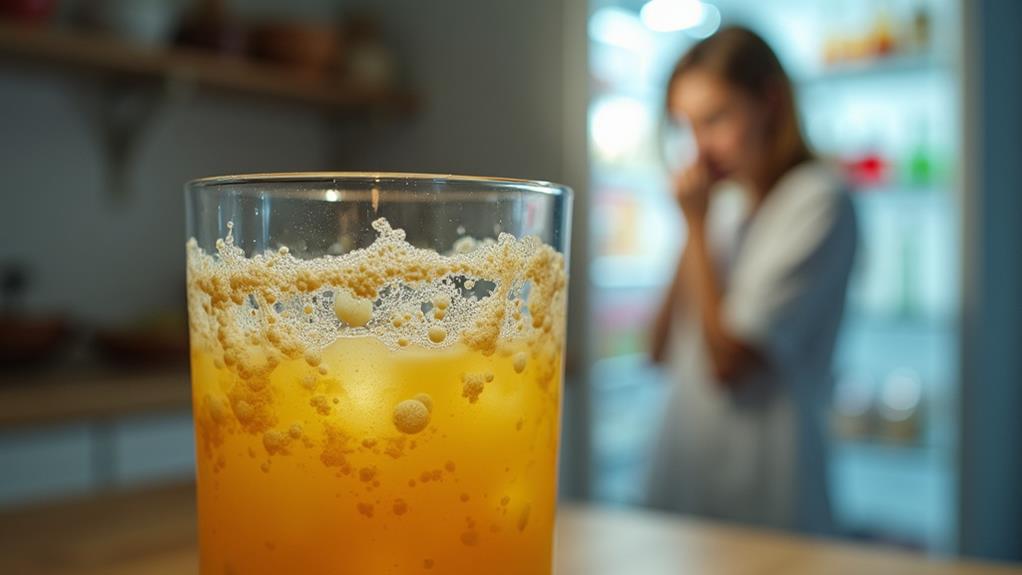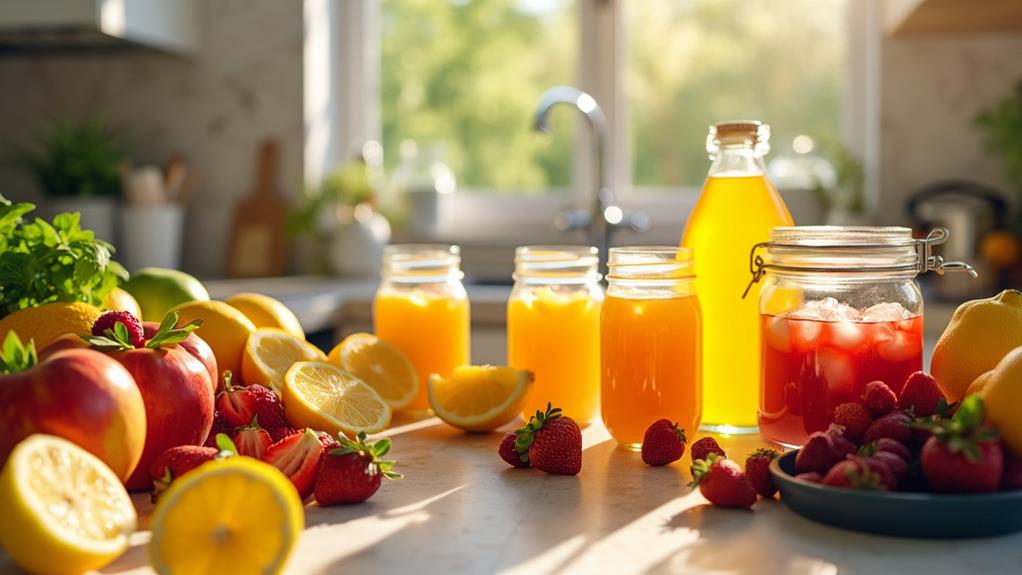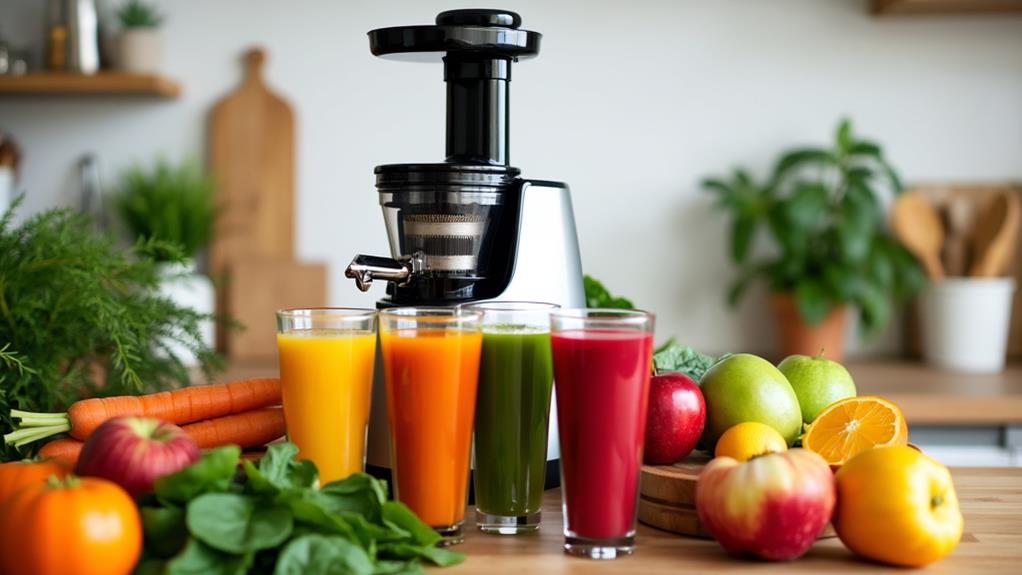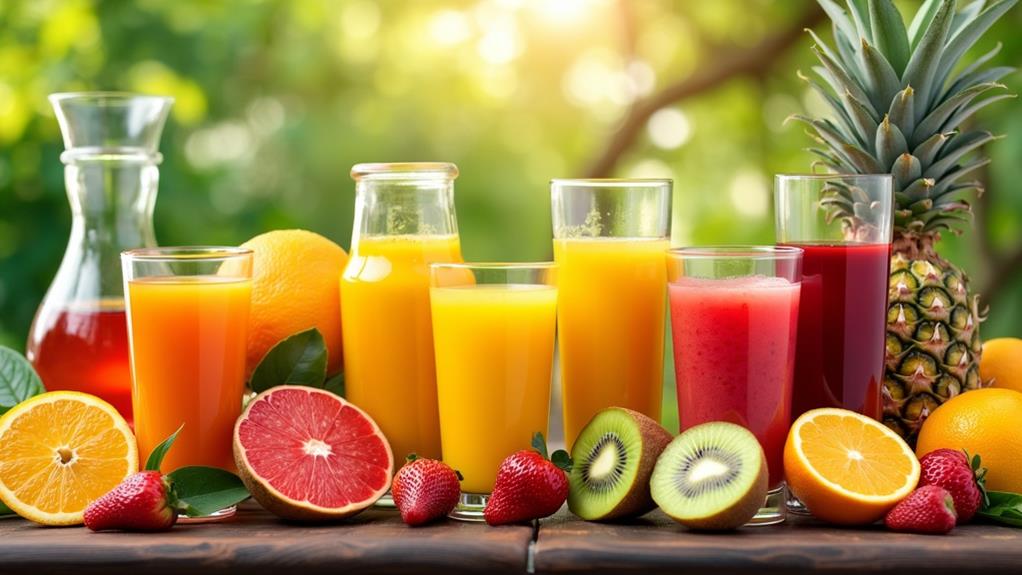Essential Tips for Fresh Juice Success
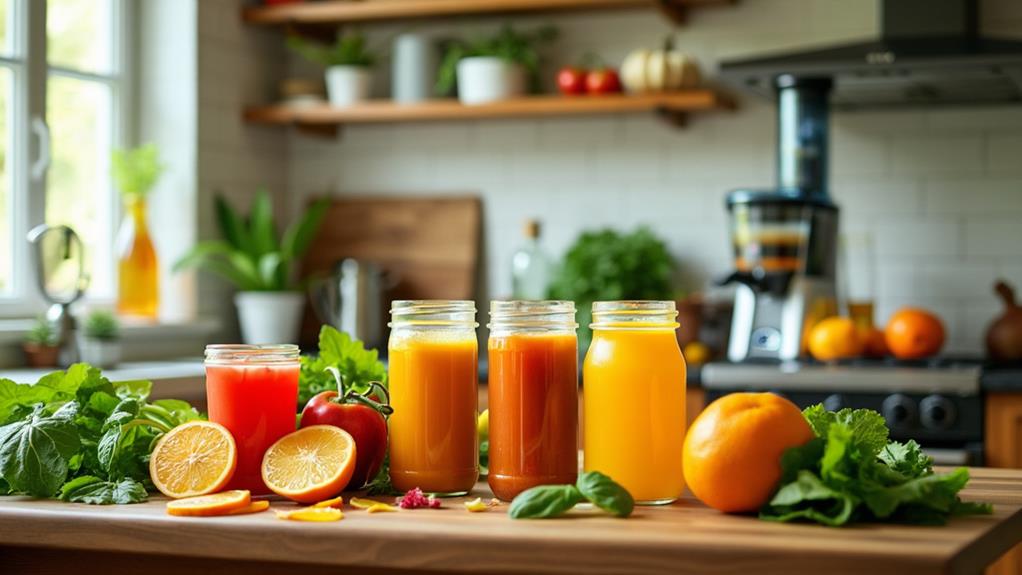
To achieve fresh juice success, consider key strategies. Start with batch juicing to prepare a week's worth of nutrient-rich recipes efficiently. Use a high-quality cold-press juicer to maximize juice yield and nutritional value. Selecting fresh, seasonal produce enhances flavor and reduces waste. Storage methods and ingredient variety are crucial for maintaining juice benefits. Curious about the best practices? Let's explore further.
Understanding Batch Juicing
Batch juicing is a time-saving strategy that allows you to enjoy fresh, nutritious juice throughout the week without daily preparation. By making large quantities of juice at once, you can easily incorporate healthy drinks into your routine. Choose a variety of nutrient-rich fruits and vegetables like carrots, beets, spinach, apples, and oranges for optimal juice yield and nutritional value.
Using the right juicer is crucial for efficiency and quality. Cold-press juicers, such as the Hurom H320, are ideal for batch juicing because they retain more nutrients and produce a higher juice yield compared to centrifugal juicers. Once prepared, store your juice in airtight glass containers to keep it fresh for up to three days in the refrigerator, protecting it from light and air exposure.
Planning and preparing recipes in advance can further streamline the batch juicing process, ensuring you have a diverse and nutritious menu while minimizing waste. By integrating batch juicing into your routine, you can consistently enjoy fresh juice, making it easier to maintain a healthy lifestyle.
Benefits of Batch Juicing
Batch juicing can streamline your daily routine, making it easier to enjoy fresh, nutritious drinks without the hassle of daily preparation. By making large quantities of juice at once, you significantly reduce your overall prep time and minimize cleanup, freeing up time for other activities.
Utilizing fresh produce before it spoils helps save money and reduce food waste. Batch juicing ensures you maximize the use of your ingredients, making it a cost-effective approach. Storing your juices in airtight containers helps maintain their freshness for several days, minimizing oxidation and preserving nutrients.
Additionally, batch juicing offers nutritional consistency. Having a ready supply of nutrient-rich juice supports your daily health goals and encourages healthier dietary choices. This is especially beneficial for larger families, ensuring everyone meets their nutritional needs with minimal effort.
Incorporating batch juicing into your routine not only enhances convenience but also promotes better health and efficiency. Enjoy the benefits of reduced prep time, decreased food waste, and consistent nutrition with this practical approach.
Essential Juicing Tools
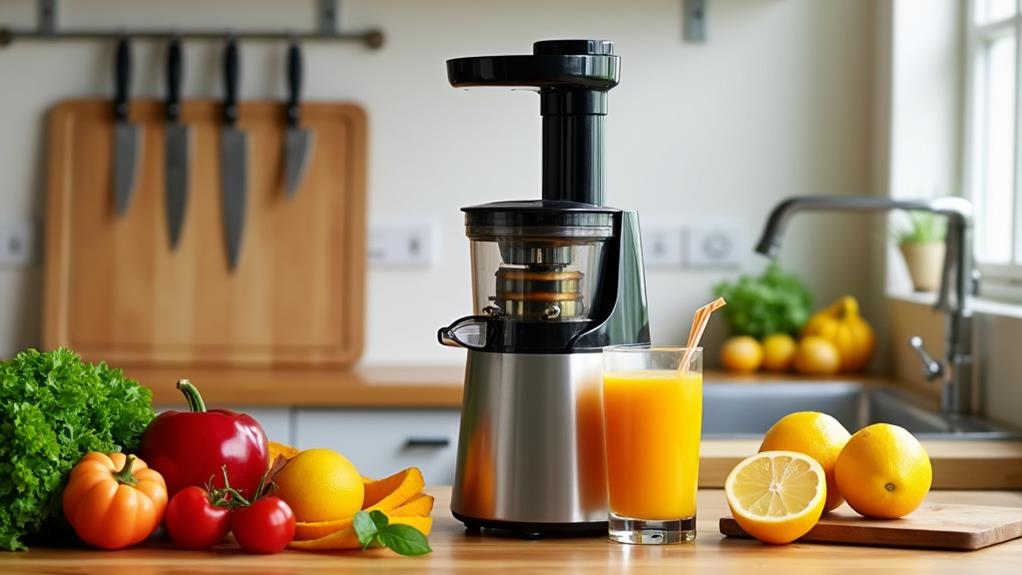
Equipping yourself with the right tools is crucial for efficient and effective juicing. Start with a high-quality cold-press juicer like the Hurom H320, which is ideal for batch juicing. Cold-press juicers preserve nutrients better than centrifugal juicers, allowing you to store your fresh juice for up to 72 hours without significant quality loss.
Sharp, durable knives and large cutting boards are essential for quickly and safely prepping fruits and vegetables. These tools minimize prep time and ensure a smooth workflow. After juicing your produce, use non-reactive wide containers to prevent any chemical reactions that might alter the taste or nutritional value of your juice.
For storage, glass mason jars or sealed containers are optimal. They reduce oxidation, keeping your fresh juice tasting great for longer. Proper storage is vital since juice oxidizes quickly.
Lastly, don't overlook the importance of cleaning your juicer. A cleanup kit with brushes and mild soap makes maintaining your juicer much easier. Immediate cleaning prevents residue buildup, ensuring your juicer lasts longer and performs efficiently. With these essential tools, you'll master the art of juicing in no time!
Storage Techniques
To maintain the quality of your fresh juice, store it in airtight glass containers to reduce oxidation and nutrient loss. Refrigerate the juice immediately and consume it within 24 hours for optimal flavor and health benefits. Using dark glass containers or wrapping clear ones in foil can further protect your juice from light degradation.
Refrigeration Best Practices
To preserve the nutritional value and freshness of your freshly made juice, proper refrigeration techniques are essential. Store your juice in airtight glass containers to minimize oxidation and maintain nutrient integrity. Glass is non-reactive, preventing any chemical leaching into your juice, unlike plastic containers. Fill the containers to the brim to reduce air space, limiting exposure to oxygen and slowing the degradation of vitamins and enzymes.
Refrigerate your juice at temperatures below 40°F (4°C) to inhibit bacterial growth and maintain freshness for up to 72 hours. Protect your juice from light exposure by using dark glass containers or wrapping clear containers in aluminum foil, as light can degrade its nutrients. To extend shelf life, consider adding a small amount of lemon or lime juice. The citric acid helps preserve freshness.
Airtight Container Benefits
Airtight containers are ideal for preserving freshly made juice, as they significantly reduce oxidation. This is crucial for maintaining the juice's freshness and nutritional value. When stored in airtight containers, juice retains its lively flavor and health benefits for a longer duration.
Glass containers are particularly beneficial as they prevent chemical leaching that can occur with plastic alternatives, ensuring that your juice remains pure and safe to consume. For optimal results, fill the containers to the brim to minimize air exposure, which helps in maintaining the juice's quality and extending its shelf life.
Labeling your containers with the date and type of juice is also important. This practice helps track freshness and ensures that older juices are consumed first, making inventory management simple and effective.
Recipe Planning
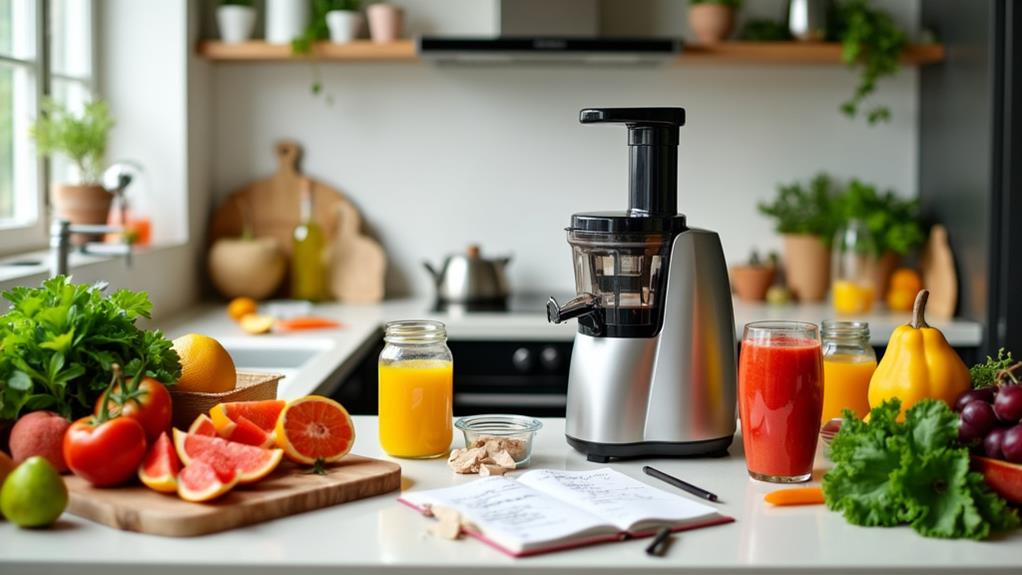
Creating a balanced juice recipe requires more than just blending random fruits and vegetables. Effective recipe planning is essential for meeting your nutritional goals. Start by researching juice recipes that combine fresh fruits and vegetables to ensure a balanced intake of vitamins and minerals. Aim to include at least three different types of produce in each recipe to optimize nutrient diversity and prevent excessive sweetness.
Utilize seasonal produce for your juice recipes. Seasonal ingredients are fresher, more flavorful, and often more economical. Plan a diverse juice menu that includes sweet, tart, earthy, and herbal elements. This approach not only enhances flavor complexity but also boosts nutritional variety.
Keeping a record of your favorite juice combinations can be highly beneficial. Documenting these combinations and their nutritional benefits allows you to easily replicate successful recipes.
Here's a simple guide to assist you with recipe planning:
| Type of Produce | Example Ingredients | Nutritional Benefits |
|---|---|---|
| Sweet Fruits | Apples, Pineapples, Grapes | Vitamins A, C, and natural sugars |
| Vegetables | Spinach, Kale, Carrots | Fiber, Iron, Vitamin K, and antioxidants |
| Herbal Additions | Mint, Basil, Ginger | Anti-inflammatory, digestive benefits |
Ingredient Selection
When selecting ingredients for your fresh juice, choose ripe, organic fruits and vegetables to maximize flavor and nutrient content. Incorporate seasonal produce for added freshness and cost-effectiveness. Limit your ingredient list to 2-3 types per juice for easier preparation. High-yield options like cucumbers and celery are excellent choices, but avoid mushy fruits that don't juice well.
Best Produce Choices
Selecting the best produce for your fresh juice is essential for optimizing both taste and nutritional value. Begin with leafy greens like spinach and kale. These are nutrient-dense, low in calories, and packed with essential vitamins, making them excellent choices. These greens add volume without excessive sugar, ensuring a healthy drink.
Next, include high-yield ingredients such as cucumbers and celery. These not only increase juice output but also help maintain hydration levels without adding many calories, ideal for a revitalizing, clean juice. To enhance natural sweetness and flavor, incorporate fruits like apples and oranges. Rich in vitamin C, these fruits boost immune support and improve overall taste.
Avoid mushy fruits like bananas and carrot greens, as they can negatively affect juice texture and may contain undesirable substances. Instead, try root vegetables like beets and ginger. These not only offer unique flavors and vibrant colors but also provide significant health benefits. By thoughtfully selecting your produce, you can create delicious and nutritious juices every time.
Seasonal Fruit Benefits
To elevate your fresh juice game, consider the seasonal advantages of fruits. Seasonal fruits are at their peak ripeness and flavor, offering the highest nutrient content and natural sweetness, making them perfect for juicing.
In winter, citrus fruits like oranges and grapefruits are plentiful, providing a rich source of vitamin C to boost immunity during the colder months. This enhances not only the taste but also the health benefits of your juice.
Summer brings an abundance of berries, such as strawberries and blueberries, which are rich in antioxidants. These fruits can enhance the flavor and color of your juices while promoting heart health.
Fall shouldn't be overlooked either; apples and pears add natural sweetness and fiber to your juices. They also contain quercetin, known for its anti-inflammatory properties, making them ideal for a revitalizing juice blend.
Juice Consumption Tips
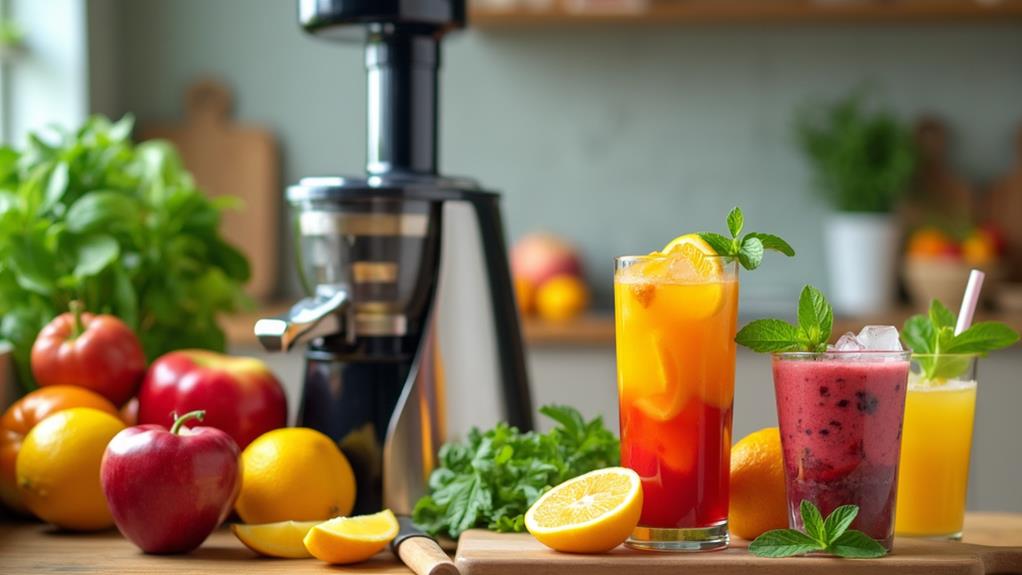
For optimal nutrient intake, consume fresh juice immediately after preparation. Drinking fresh juice right away ensures you receive the maximum nutritional benefits. If immediate consumption isn't possible, aim to drink it within 24 hours. Store your juice in tightly sealed glass containers to prevent chemical leaching and minimize oxidation.
Refrigerate your juice if you can't consume it immediately. Keeping it cold slows bacterial growth and helps preserve freshness and flavor. Even with refrigeration, try to consume your juice within 2 days to maintain peak taste and nutrient levels.
If you need to freeze your juice, thaw it using the refrigerator or cold water methods, and consume it within 24 hours after thawing. Avoid using heat sources for thawing, as they can degrade nutrients.
Regularly check the juice for changes in color, consistency, and flavor after storage. These changes can indicate nutrient degradation and potential spoilage. By following these tips, you can enjoy fresh juice that is both delicious and nutritious.
Common Juicing Mistakes
Avoiding common juicing mistakes can significantly enhance the quality and nutritional value of your juice. One frequent error is relying too much on fruit juices. While fruits are tasty, they can be high in sugar and lack essential nutrients. Balance your recipes by adding vegetables to boost health benefits.
Another mistake is neglecting to clean your juicer components immediately after use. Delayed cleaning can lead to bacterial growth and make the residue harder to remove, potentially shortening your juicer's lifespan.
Failing to include a variety of ingredients is also a critical misstep. Using the same few components limits nutrient diversity, undermining the health benefits you're aiming for. Mix it up to ensure a broad range of vitamins and minerals.
It's crucial to consider your personal health conditions and dietary restrictions when selecting ingredients. Ignoring these factors can cause adverse reactions or nutrient deficiencies. Tailor your juices to meet your individual needs.

